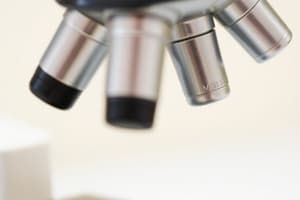Podcast
Questions and Answers
What is the significance of the numerical aperture (N.A.) in microscopy?
What is the significance of the numerical aperture (N.A.) in microscopy?
- It determines the brightness of the microscope
- It measures the resolving power of the microscope (correct)
- It specifies the magnification power of the lenses
- It indicates the type of light source used
Which type of microscope uses reflected light to enhance contrast in unstained specimens?
Which type of microscope uses reflected light to enhance contrast in unstained specimens?
- Bright field microscope
- Dark field microscope (correct)
- Phase contrast microscope
- Scanning electron microscope
What does the term 'microscopy' refer to?
What does the term 'microscopy' refer to?
- The process of illuminating slides for viewing
- The technique used to measure lens quality
- The practice of producing large images
- The science of investigating small objects (correct)
In optical microscopes, what is the main purpose of the eyepiece lens?
In optical microscopes, what is the main purpose of the eyepiece lens?
Which of the following statements about fluorescence microscopy is correct?
Which of the following statements about fluorescence microscopy is correct?
What role does the objective lens play in an optical microscope?
What role does the objective lens play in an optical microscope?
What unique feature do phase contrast microscopes offer compared to bright field microscopes?
What unique feature do phase contrast microscopes offer compared to bright field microscopes?
What does the term 'inverted image' refer to in microscopy?
What does the term 'inverted image' refer to in microscopy?
What type of microscopy uses a laser beam to illuminate spots on a specimen and scans the region point by point?
What type of microscopy uses a laser beam to illuminate spots on a specimen and scans the region point by point?
Which of the following statements accurately describes the Transmission Electron Microscope (TEM)?
Which of the following statements accurately describes the Transmission Electron Microscope (TEM)?
Which feature distinguishes Scanning Electron Microscope (SEM) from Transmission Electron Microscope (TEM)?
Which feature distinguishes Scanning Electron Microscope (SEM) from Transmission Electron Microscope (TEM)?
What is the primary purpose of confocal microscopy in biological research?
What is the primary purpose of confocal microscopy in biological research?
What type of imaging does SEM produce and how does it achieve this?
What type of imaging does SEM produce and how does it achieve this?
What is the primary function of a stereo microscope?
What is the primary function of a stereo microscope?
How does a stereo microscope achieve three-dimensional visualization?
How does a stereo microscope achieve three-dimensional visualization?
What is the primary purpose of an otoscope?
What is the primary purpose of an otoscope?
Which of the following statements is true regarding stereo microscopes and compound microscopes?
Which of the following statements is true regarding stereo microscopes and compound microscopes?
What is a notable characteristic of the stereo microscope in terms of working distance and depth of field?
What is a notable characteristic of the stereo microscope in terms of working distance and depth of field?
Which feature of some otoscope models allows for the insertion of other instruments?
Which feature of some otoscope models allows for the insertion of other instruments?
What can an otoscope be used to examine?
What can an otoscope be used to examine?
What does the use of oil immersion objectives enhance in microscopy?
What does the use of oil immersion objectives enhance in microscopy?
In the context of microscopy, what does the Abbe Equation relate?
In the context of microscopy, what does the Abbe Equation relate?
What is the resolving power of a microscope primarily dependent on?
What is the resolving power of a microscope primarily dependent on?
What does a puff of air from the otoscope help to test?
What does a puff of air from the otoscope help to test?
How is the actual magnification of a microscope calculated?
How is the actual magnification of a microscope calculated?
Why should stereo microscopes not be confused with ordinary compound microscopes equipped with binocular eyepieces?
Why should stereo microscopes not be confused with ordinary compound microscopes equipped with binocular eyepieces?
Which of the following factors limits the resolution of bright field microscopy?
Which of the following factors limits the resolution of bright field microscopy?
What is an essential component of an otoscope?
What is an essential component of an otoscope?
Which wavelength of light provides the best resolution in microscopy?
Which wavelength of light provides the best resolution in microscopy?
What enhances contrast in phase contrast microscopy?
What enhances contrast in phase contrast microscopy?
Which term describes the emission of light by substances that have absorbed electromagnetic radiation?
Which term describes the emission of light by substances that have absorbed electromagnetic radiation?
In fluorescence microscopy, what do fluorophores typically absorb?
In fluorescence microscopy, what do fluorophores typically absorb?
What role does the confocal microscope play in imaging tissue?
What role does the confocal microscope play in imaging tissue?
What phenomenon occurs before a fluorescent dye emits light?
What phenomenon occurs before a fluorescent dye emits light?
Which technique involves scattering of light to generate contrast in a sample?
Which technique involves scattering of light to generate contrast in a sample?
What type of microscopy would you use to measure enzyme activity in live cells?
What type of microscopy would you use to measure enzyme activity in live cells?
What is a key characteristic of fluorescence that differentiates it from other types of luminescence?
What is a key characteristic of fluorescence that differentiates it from other types of luminescence?
Flashcards are hidden until you start studying
Study Notes
Microscope
- A microscope is an instrument used to view objects too small for the naked eye.
- The term "microscope" was coined in 1628 by Johannes Faber, combining the Greek words "micro" (small) and "skopein" (to view).
- Microscopy is the science of investigating small objects using microscopes.
- The most common microscope is the optical microscope, which uses lenses to produce an enlarged image of an object.
- There are two types of optical microscopes: Simple Optical Microscopes and Compound Optical Microscopes.
Optical Principles of Microscope
- The objective lens is a high-powered magnifying glass with a short focal length, creating a virtual and enlarged image of the specimen.
- The eyepiece lens further magnifies the virtual image.
- The image is viewed with the eyes focused at infinity.
- The actual power (magnification) of the microscope is calculated by multiplying the power of the eyepiece by the power of the objective lens.
Stereo Microscope
- The Stereo or Dissecting microscope differs from a compound microscope in that it uses two separate optical paths with two objectives, each providing a different viewing angle to each eye.
- This creates a 3-D visualisation of the sample being examined.
- Stereo Microscopes are often used for examining surfaces, sorting, dissection, microsurgery, watch-making, and small circuit board manufacture or inspection.
- Larger working distances and depths of field are important for Stereo Microscopes.
Bright Field Microscopy
- Bright Field Microscopy is best suited for observing dark or strongly refracting objects.
- It has a low optical resolution, limited by diffraction to approximately 0.2 microns.
- Out-of-focus light reduces image clarity.
- Enhancements include oil immersion objectives, staining methods, and using filters on the light source.
Numerical Aperture (N.A.) and Resolution (R)
- Resolution is the ability to distinguish between two closely spaced objects.
- The resolution limit of a microscope is dependent on the wavelength of light and the numerical aperture (N.A.) of the lens system.
- The Abbe Equation: Resolution (Limit) ~ λ/NA ~ λ/2n Sinθ ~ λ/n Sinθ
- Wavelength (λ) is shorter for blue light (450nm) and longer for red light (750nm).
- A smaller wavelength or a larger N.A. results in better resolution.
Phase Contrast Microscopy
- Phase contrast microscopy enhances the visibility of transparent objects by altering the phase of light passing through the specimen.
- This creates contrast between the object and its surroundings.
Fluorescence Microscopy
- Fluorescence microscopy employs fluorescence and phosphorescence to visualize specimens.
- Fluorescence is the emission of light by a substance that has absorbed light or other electromagnetic radiation.
- Fluorescent dyes (fluorophores) absorb excitation light at a specific wavelength and emit light at a longer wavelength.
- Applications include studying live cells, fixed cells, and localizing or measuring enzyme activity.
Confocal Microscopy
- Confocal microscopy uses a laser beam to illuminate a thin slice within tissue and reject light from other regions, creating a 3-D image.
- It is used extensively in biological and medical research.
Electron Microscopy
- Electron microscopy uses a beam of electrons to create images of specimens.
- Transmission Electron Microscopy (TEM) provides a 2-D view of thin slices with extremely high magnification and resolution.
- Scanning Electron Microscopy (SEM) provides a 3-D view of the surface of the specimen with high magnification and resolution.
Studying That Suits You
Use AI to generate personalized quizzes and flashcards to suit your learning preferences.




